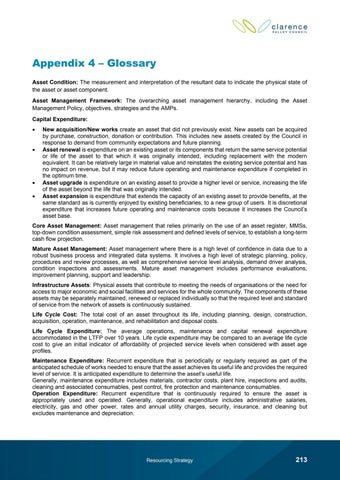Appendix 4 – Glossary Asset Condition: The measurement and interpretation of the resultant data to indicate the physical state of the asset or asset component. Asset Management Framework: The overarching asset management hierarchy, including the Asset Management Policy, objectives, strategies and the AMPs. Capital Expenditure: • •
• •
New acquisition/New works create an asset that did not previously exist. New assets can be acquired by purchase, construction, donation or contribution. This includes new assets created by the Council in response to demand from community expectations and future planning. Asset renewal is expenditure on an existing asset or its components that return the same service potential or life of the asset to that which it was originally intended, including replacement with the modern equivalent. It can be relatively large in material value and reinstates the existing service potential and has no impact on revenue, but it may reduce future operating and maintenance expenditure if completed in the optimum time. Asset upgrade is expenditure on an existing asset to provide a higher level or service, increasing the life of the asset beyond the life that was originally intended. Asset expansion is expenditure that extends the capacity of an existing asset to provide benefits, at the same standard as is currently enjoyed by existing beneficiaries, to a new group of users. It is discretional expenditure that increases future operating and maintenance costs because it increases the Council’s asset base.
Core Asset Management: Asset management that relies primarily on the use of an asset register, MMSs, top-down condition assessment, simple risk assessment and defined levels of service, to establish a long-term cash flow projection. Mature Asset Management: Asset management where there is a high level of confidence in data due to a robust business process and integrated data systems. It involves a high level of strategic planning, policy, procedures and review processes, as well as comprehensive service level analysis, demand driver analysis, condition inspections and assessments. Mature asset management includes performance evaluations, improvement planning, support and leadership. Infrastructure Assets: Physical assets that contribute to meeting the needs of organisations or the need for access to major economic and social facilities and services for the whole community. The components of these assets may be separately maintained, renewed or replaced individually so that the required level and standard of service from the network of assets is continuously sustained. Life Cycle Cost: The total cost of an asset throughout its life, including planning, design, construction, acquisition, operation, maintenance, and rehabilitation and disposal costs. Life Cycle Expenditure: The average operations, maintenance and capital renewal expenditure accommodated in the LTFP over 10 years. Life cycle expenditure may be compared to an average life cycle cost to give an initial indicator of affordability of projected service levels when considered with asset age profiles. Maintenance Expenditure: Recurrent expenditure that is periodically or regularly required as part of the anticipated schedule of works needed to ensure that the asset achieves its useful life and provides the required level of service. It is anticipated expenditure to determine the asset’s useful life. Generally, maintenance expenditure includes materials, contractor costs, plant hire, inspections and audits, cleaning and associated consumables, pest control, fire protection and maintenance consumables. Operation Expenditure: Recurrent expenditure that is continuously required to ensure the asset is appropriately used and operated. Generally, operational expenditure includes administrative salaries, electricity, gas and other power, rates and annual utility charges, security, insurance, and cleaning but excludes maintenance and depreciation.
Resourcing Strategy
213




